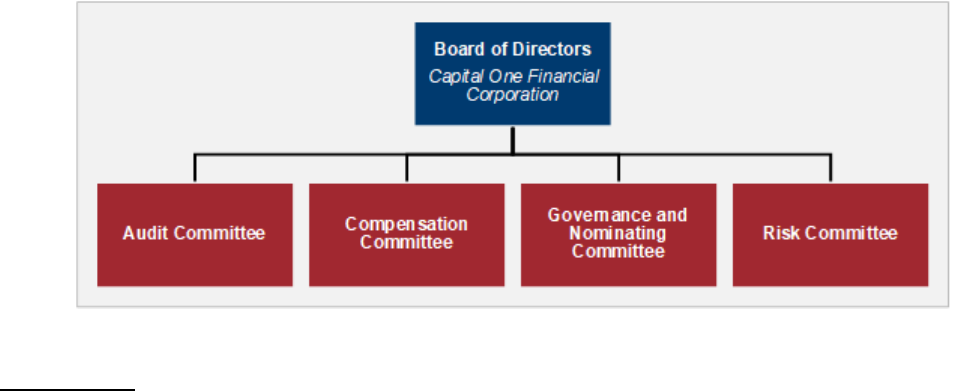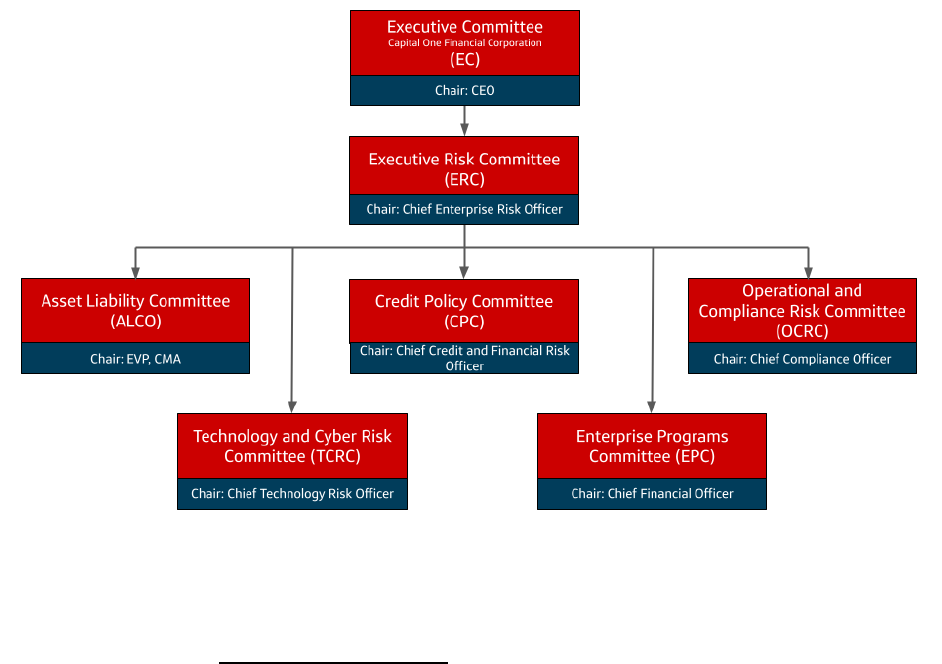NOTIFICATION
to the
BOARD OF GOVERNORS OF THE FEDERAL RESERVE SYSTEM
by
CAPITAL ONE FINANCIAL CORPORATION
in connection with the acquisition of
DISCOVER FINANCIAL SERVICES AND ITS NONBANKING SUBSIDIARIES
pursuant to Sections 4(c)(8) and 4(j)
of the Bank Holding Company Act of 1956, as amended
and Section 225.24 of Regulation Y
March 20, 2024

Board of Governors of the Federal Reserve System
Notification by a Bank Holding Company to Acquire a
Nonbank Company and/or Engage in Nonbanking Activities
Capital One Financial Corporation
Corporate Title of Notificant
1680 Capital One Drive
Street
McLean
City
Virginia
State
22102
Zip Code
Hereby provides the Board with a notice pursuant to:
(1) Section 4(c)(8) and 4(j) of the Bank Holding Company Act of 1956, as amended (“BHC Act”— 12 U.S.C. 1843), under
the “Expedited action for certain nonbanking proposals by well-run bank holding companies” as described in section
225.23 of Regulation Y; or
(2) Section 4(c)(8) and 4(j) of the BHC Act, under the “Procedures for other nonbanking proposals” as described in section
225.24 of Regulation Y;
for prior approval to engage directly or indirectly in certain nonbanking activities, de novo, through acquisition of the assets of a
going concern, or through direct or indirect ownership, control, or power to vote at least 100% of the voting shares of:
DFS Services LLC (primarily engaged in financial data processing, including payments, lending and related servicing)
Corporate Title of Company to be Acquired and/or Description of Nonbanking Activity
2500 Lake Cook Road
Street
Riverwoods Illinois 60015
City State Zip Code

Discover Financial Services (Canada), Inc. (primarily engaged in financial data processing, including payments)
Corporate Title of Company to be Acquired and/or Description of Nonbanking Activity
Three Bentall Center, 595 Burrard St., Suite 2600
Street
Vancouver British Columbia, Canada V7X1L3
City State Zip Code
PULSE Network LLC
(engaged i
n
financial data processing, including payments)
Corporate Title of Company to
be
Acquired
and/or Description
of Nonbanking
Activity
1301 McKinn
ey, Suite 600
Street
Houston Texas 77010
City State Zip Code
Diners Club
International Ltd.
(p
rimarily engaged in
financial data processing, including
payments, lending and related servicing)
Corporate Title of Company to
be
Acquired
and/or Description
of Nonbanking
Activity
2500 Lake C
ook Road
Street
Riverwoods Illinois 60015
City State Zip Code
Diners Club Services Private Ltd.– India (primarily engaged in financial data processing, including payments)
Corporate Title of Company to be Acquired and/or Description of Nonbanking Activity
Level 1, First International Financial Centre, Plot No C-54 and C-55 G Block
Street
Mumbai India 400051
City State Zip Code
Diners Club Services Taiwan Ltd. (engaged in
financial
data
processing, including payments)
Corporate Title of Company to
be
Acquired
and/or Description
of Nonbanking
Activity
15-2, No. 1
68, Sec. 3, Nanjing E. Rd
Street
Taipei Taiwan
N
/A
City State Zip Code
Does Notificant request confidential treatment for any portion of this submission?
Yes
As required by the General Instructions, a letter justifying the request for confidential treatment is included.
The information for which confidential treatment is being sought is separately bound and labeled “CONFIDENTIAL.”
No
Public Reporting Burden for this collection of information is estimated to average 0.5
hours for a post-consummation notification, 5 hours for an expedited notification, and
12 hours for a complete notification, including the time to gather and maintain data in
the required form, to review instructions, and to complete the information collection.
Send comments regarding this burden estimate or any other aspect of this collection of
information, including suggestions for reducing this burden to: Secretary, Board of
Governors of the Federal Reserve System, 20th and C Streets, N.W., Washington,
D.C. 20551; and to the Office of Management and Budget, Paperwork Reduction
Project (7100-0121), Washington, D.C. 20503. The Federal Reserve may not
conduct or sponsor, and an organization or a person is not required to respond to a
collection of information unless it displays a currently valid OMB control number.

Name, title, address, telephone number and facsimile number of person(s) to whom inquiries concerning this notification may be directed:
Rosemary Spaziani, Esq.
Wachtell, Lipton, Rosen & Katz, 51 W. 52
nd
Street, New York, NY 10019
(212) 403-1342, (212) 403-2354 (fax)
with a copy to:
Richard K. Kim, Esq.
Wachtell, Lipton, Rosen & Katz, 51 W. 52
nd
Street, New York, NY 10019
(212) 403-1354, (212) 403-2354 (fax)
Certification
I certify that the information contained in this notification has been
examined carefully by me and is true, correct, and complete, and is current
as of the date of this submission to the best of my knowledge and belief.
I acknowledge that any misrepresentation or omission of a material fact
constitutes fraud in the inducement and may subject me to legal sanctions
provided by 18 USC 1001 and 1007.
I also certify, with respect to any information pertaining to an individual
and submitted to the Board in (or in connection with) this notification, that
the notificant has the authority, on behalf of the individual, to provide such
information to the Board and to consent or to object to public release of
such information. I certify that the notificant and the involved individual
consent to public release of any such information, except to the extent set
forth in a written request by the notificant or the individual, submitted in
accordance with the Instructions to this form and the Board’s Rules
Regarding Availability of Instructions to this form
and the Board’s Rules Regarding Availability of Information (12 CFR
Part 261), requesting confidential treatment for the information.
I acknowledge that approval of this notification is in the discretion of
the Board of Governors of the Federal Reserve System (the “Federal
Reserve”). Actions or communications, whether oral, written, or
electronic, by the Federal Reserve or its employees in connection with
this filing, including approval if granted, do not constitute a contract,
either express or implied, or any other obligation binding upon the
agency, the United States or any other entity of the United States, or
any officer or employee of the United States. Such actions or
communications will not affect the ability of the Federal Reserve to
exercise its supervisory, regulatory, or examination powers under
applicable laws and regulations. I further acknowledge that the
foregoing may not be waived or modified by any employee or agency
of the Federal Reserve or of the United States.
Signed this ____ _______ day of _March_______________, _2024_.
20th
Signature of Chief Executive Officer or Designee
Typed Name and Title
Matthew Cooper, General Counsel & Corporate Secretary

TABLE OF CONTENTS
Page
Introductory Statement.....................................................................................................................2
Overview of the Proposed Transaction
Permissibility of the Discover Nonbanking Companies Acquisition under the BHC
......................................................................................3
Required Approvals ...................................................................................................................3
Act ........................................................................................................................................4
Financial and Managerial Resources .........................................................................................5
Management ...............................................................................................................................9
Impact on Competition ............................................................................................................23
Public Benefits of the Acquisition ...........................................................................................24
Conclusion .....................................................................................................................................25
Information Required by Section 225.23 of Regulation Y............................................................26
Exhibits ..........................................................................................................................................28
Confidential Exhibits .....................................................................................................................28
-i-

Request for Confidential Treatment
Confidential treatment is being requested under the federal Freedom of Information Act,
5 U.S.C. § 552 (the “FOIA”), and the implementing regulations of the Board of Governors of the
Federal Reserve System (the “Federal Reserve”), for the information contained in the
Confidential Exhibits Volume to this application (the “Confidential Materials”). The
Confidential Materials include, for example, nonpublic pro forma financial information and
information regarding the business strategies and plans of (1) Capital One Financial Corporation
(“COFC”), Vega Merger Sub, Inc. (“Merger Sub”) and Capital One, National Association
(“CONA”) and (2) Discover Financial Services (“Discover”) and Discover Bank (“Discover
Bank”), and other information regarding additional matters of a similar nature, which is
commercial or financial information that is both customarily and actually treated as private by
COFC, Merger Sub, CONA, Discover and Discover Bank and provided to the government under
an assurance of privacy. Certain information in the Confidential Materials also includes
“confidential supervisory information” as defined in the Federal Reserve’s regulations at 12 CFR
§ 261.2, which is protected from disclosure. None of this information is the type of information
that would otherwise be made available to the public under any circumstances. All such
information, if made public, could result in substantial and irreparable harm to COFC, Merger
Sub, CONA, Discover and Discover Bank. Other exemptions from disclosure under the FOIA
may also apply. In addition, investors and potential investors could be influenced or misled by
such information, which is not reported in any documents filed or to be filed in accordance with
the disclosure requirements of applicable securities laws, as a result of which COFC, Merger
Sub, CONA, Discover and Discover Bank could be exposed to potential inadvertent violations of
law or exposure to legal claims. Accordingly, confidential treatment is respectfully requested for
the Confidential Materials under the FOIA and the Federal Reserve’s implementing regulations.
Please contact Rosemary Spaziani (212-403-1342) or Richard K. Kim (212-403-1354)
before any public release of any of this information pursuant to a request under the FOIA or a
request or demand for disclosure by any governmental agency, congressional office or
committee, court or grand jury. Such prior notice is necessary so that COFC, Merger Sub,
CONA, Discover and Discover Bank may take appropriate steps to protect such information
from disclosure.
-1-

Introductory Statement
This Notification to the Board of Governors of the Federal Reserve System (the “Federal
Reserve”), pursuant to Section 4(c)(8) and 4(j) of the Bank Holding Company Act of 1956, as
amended
1
(the “BHC Act”), relates to the acquisition by Capital One Financial Corporation,
McLean, Virginia (“COFC”, together with its subsidiaries, “Capital One” or the “Company”) of
Discover Financial Services (“Discover”) and its subsidiaries (excluding Discover Bank and
Discover Bank’s subsidiaries) (the “Discover Nonbanking Companies”) via a merger of
Discover with and into COFC with a multi-step transaction (the “Proposed Transaction”).
The organizational chart provided in Exhibit 1 sets forth the entities that Capital One is
acquiring pursuant to the Proposed Transaction and highlights those Discover Nonbanking
Companies, which are related to this Notification. As detailed in Exhibit 2, Discover
Nonbanking Companies engage in permissible payment activities permissible under Section
4(c)(8) of the BHC Act and Subpart C of Regulation Y, as having been determined to be so
closely related to banking as to be a proper incident thereto. Capital One is requesting prior
Board approval under Section 4(c)(8) of the BHC Act to acquire the Discover Nonbanking
Companies.
The Discover Nonbanking Companies operate the Discover Network, the PULSE
network (“PULSE”) and Diners Club International (“Diners Club”), collectively known as the
“Discover Global Network.” The Discover Network processes transactions for Discover-
branded credit and debit cards and provides payment processing and settlement services. PULSE
operates an electronic funds transfer network, providing financial institutions issuing debit cards
on the PULSE network with access to ATMs domestically and internationally, as well as
merchant acceptance throughout the United States for debit card transactions. Diners Club is a
global payments network of licensees, which are generally financial institutions, that issue
Diners Club branded charge cards and/or provide card acceptance services. Discover provides
Diners Club licensees with payment processing and settlement services for transactions, as well
as a centralized service center and technological services.
With the acquisition of the Discover Nonbanking Companies, Capital One will scale and
leverage the benefits its eleven-year technology transformation across the Discover payments
network to provide customers and merchants expanded products and services within Capital
One’s robust risk management framework.
For the reasons discussed in this Notification, Capital One respectfully submits that the
acquisition of the Discover Nonbanking Companies fully satisfies the statutory factors that the
Federal Reserve is required to consider under the BHC Act and that the acquisition of the
Discover Nonbanking Companies merits the Board’s approval.
1
12 U.S.C. § 1843(c)(8).
-2-

Overview of the Proposed Transaction
COFC, Merger Sub and Discover entered into the Agreement and Plan of Merger on
February 19, 2024 (the “Agreement”), for COFC to acquire Discover through a merger and,
thereby indirectly acquire Discover Bank. Each outstanding share of Discover’s common stock
(“Discover Common Stock”) will be converted into the right to receive 1.0192 shares (the
“Exchange Ratio”) of COFC common stock (the “COFC Common Stock”). Each outstanding
share of Discover preferred stock will be converted into the right to receive one share of a newly
created series of COFC preferred stock having materially the same terms as the applicable series
of Discover preferred stock.
In the Proposed Transaction, there will be three mergers, all part of a single, integrated
transaction. First, Merger Sub will merge with and into Discover, with Discover continuing as
the surviving corporation to effectuate the “First Step Merger.” Immediately following the First
Step Merger, the “Second Step Merger” will occur in which Discover will merge with and into
COFC, with COFC continuing as the surviving corporation and, following the Second Step
Merger, the separate corporate existence of Discover will cease. Immediately following the
Second Step Merger, the Bank Merger will take place in which Discover Bank will merge with
and into CONA, with CONA continuing as the surviving entity and the separate corporate
existence of Discover Bank will cease to exist.
See the summary of terms of the Proposed Transaction provided in Exhibit 3.
On consummation of the Proposed Transaction, the subsidiaries of Discover Bank will
become subsidiaries of CONA and the other direct and indirect subsidiaries of Discover will
become direct or indirect subsidiaries of COFC. In Exhibit 1, please find the current
organizational chart of Discover, which sets forth the entities to be acquired by Capital One,
including the Discover Nonbanking Companies described in Exhibit 2. In Confidential Exhibit
A, please find a pro forma organizational chart of COFC.
The Proposed Transaction will substantially enhance Capital One’s ability to distribute its
broad suite of consumer and business banking products and services, and better position the
combined organization to compete with the largest banking organizations in the United States.
Required Approvals
An application to the Federal Reserve by COFC and Merger Sub, requesting approval
to acquire Discover and thereby Discover Bank, pursuant to sections 3(a)(3) and (5)
of the BHC Act, and section 225.15 of Regulation Y (the “FRB Application”);
An application to the OCC for prior approval for Discover Bank to merge with and
into CONA, with CONA as the surviving institution, pursuant to the Bank Merger
Act and to operate Discover Bank’s branch as a licensed branch of CONA pursuant to
-3-

the Bank Merger Act, section 36(d) of the National Bank Act and the OCC’s
implementing regulations (the “OCC Application”);
2
and
An application to the Delaware State Bank Commissioner for prior approval to
acquire control of Discover Bank immediately prior to the Bank Merger, pursuant to
Title 5 Del. C. § 843, and for a waiver of the 30% state deposit concentration limit
pursuant to Title 5 Del. C. § 795H.
Permissibility of the Discover Nonbanking Companies Acquisition under the BHC Act
Section 4(c)(8) of the BHC Act permits a bank holding company to acquire “shares of
any company the activities of which had been determined by the Board by regulation or order
under this paragraph as of the day before November 12, 1999, to be so closely related to banking
as to be a proper incident thereto (subject to such terms and conditions contained in such
regulation or order, unless modified by the Board).”
3
Section 225.28(b) of the Board’s
Regulation Y sets forth a list of activities that the Board has previously determined to be
permissible under Section 4(c)(8). Among the permissible activities are those engaged in by the
Discover Nonbanking Subsidiaries, namely:
Payments and data processing, permissible under 12 CFR § 225.28(b)(14); and
Extensions of credit, loan servicing and other activities related thereto, permissible
under 12 CFR § 225.28(b)(1)-(2).
Certain of the Discover Nonbanking Companies are also engaged in providing services to
affiliates, as permissible under 12 CFR § 225.22(b). Based on the diligence it has conducted to
date, Capital One understands that the activities and investments of the Discover Nonbanking
Companies are permissible for bank holding companies. Please refer to Exhibit 2 for additional
information on which activities are conducted in each of the Discover Nonbanking Subsidiaries.
In considering a proposal by a bank holding company to acquire a nonbank company, the
Board is required under Section 4(j)(2)(A) of the BHC Act to consider whether the proposal “can
reasonably be expected to produce benefits to the public that outweigh possible adverse effects,
such as undue concentration of resources, decreased or unfair competition, conflicts of interest,
unsound banking practices or risk to the stability of the United States banking or financial
system.”
4
As part of its consideration of these factors, the Board also reviews the financial and
managerial resources of the companies involved, the effect of the proposal on competition in the
relevant markets and the public benefits of the proposal. As discussed below, Capital One
submits that the proposed acquisition by Capital One of the Discover Nonbanking Companies
satisfies all of the factors that the Board is required to consider under the BHC Act.
2
12 U.S.C. §§ 24, 36(d), 1828(c) and 1831u; 12 CFR §§ 5.33 and 5.34. This OCC Application will also cover the
operating subsidiaries of the Bank Merger.
3
12 U.S.C. § 1843(c)(8).
4
12 U.S.C. § 1843(j)(2)(A) (as amended by Section 604(e) of the Dodd Franke Act, effective July 21, 2011).
-4-

Financial and Managerial Resources
The Proposed Transaction will introduce the Discover Global Network to Capital One.
Currently, Discover processes approximately 5% of total debit purchase volume and 4% of total
credit purchase volume in the United States. Capital One expects to utilize its strong credit card
issuance platform to drive increased volume to the Discover Global Network, which, coupled
with expected additional investments in the Discover Global Network, position the Discover
Global Network to compete more effectively with Visa, Mastercard, and Amex.
Capital One has strong financial, capital, liquidity and managerial resources, including a
robust risk management framework (“RMF”), that will enable it to consummate the Proposed
Transaction, successfully integrate the operations of Discover into Capital One and Discover
Bank into CONA, and ensure the continued safe and sound operation of Capital One, including
the Discover Nonbanking Companies, going forward.
Senior management of Capital One will continue to take steps to ensure that COFC
maintains suitable capital planning, liquidity management, managerial resources, corporate
governance, enterprise risk management programs, compliance and technological infrastructure
commensurate with its size, complexity, risk profile, and scope of operations and otherwise meet
the Federal Reserve’s and OCC’s supervisory expectations. As a Category III organization
under the Federal Reserve’s prudential standards for large bank holding companies (Regulation
YY, 12 CFR part 252), COFC has already been subject to enhanced prudential supervisory
standards, including the Supplementary Leverage Ratio, Countercyclical Capital Buffer
requirements of the banking agencies’ regulatory capital rules, company-run capital stress testing
and single counterparty credit limits, as well as the liquidity coverage ratio requirement (the
“LCR”) and net stable funding requirement (the “NSFR”) and resolution planning requirements.
5
COFC has satisfactorily met all these requirements and standards and will continue to have the
governance, infrastructure and systems to meet all the relevant regulatory requirements and
supervisory expectations for a Category III banking organization. Furthermore, the Proposed
Transaction will have the effect of bringing the assets, liabilities and operations of the Discover
organization under the heightened requirements applicable to Category III organizations,
described above.
A. Financial, Capital and Liquidity Strength
Since January 1, 2020, the federal banking agencies’ capital and liquidity rules classify
all banking organizations with $100 billion or more in total consolidated assets into one of four
categories (Category I, II, III or IV), based on the banking organization’s asset size and risk
profile, with the most stringent capital and liquidity requirements applicable to Category I firms
and the least restrictive requirements applying to Category IV firms. Based on this regulatory
framework, COFC currently qualifies as a Category III organization. Following the Proposed
Transaction, COFC will have approximately $646 billion in total consolidated assets and will
remain well under $75 billion in cross-jurisdictional activity. Capital One would become subject
5
See Prudential Standards for Large Bank Holding Companies, Savings and Loan Holding Companies, and Foreign
Banking Organizations, 84 Fed. Reg. 59032 (Nov. 1, 2019).
-5-

to Category II standards if it has $700 billion or more in total consolidated assets or $75 billion
or more in cross-jurisdictional activity, each as measured based on the average for the four most
recent calendar quarters.
6
Accordingly, upon consummation of the Proposed Transaction, the
combined organization will continue to be a Category III firm. Capital One understands the
additional regulatory requirements applicable to Category II firms and will be prepared to meet
such additional requirements to the extent future growth results in Capital One exceeding the
applicable thresholds for classification as a Category II firm.
Capital. Capital One employs comprehensive and rigorous capital planning and capital
stress testing programs, and the acquired operations of Discover will be covered by these
effective programs. The respective capital and leverage ratios of COFC, CONA, Discover and
Discover Bank exceed the minimum ratios necessary for “well capitalized” status and, on
consummation of the Proposed Transaction, the capital ratios and leverage ratios of COFC and
CONA are projected to exceed the required minimum levels necessary for “well capitalized”
status and meet supervisory expectations. The Proposed Transaction is expected to result in a
holding company and bank with stronger financial and operating metrics, and increased
profitability and scale that will permit the combined organization to better compete against the
largest banking organizations and larger regional banking organizations in the United States.
Liquidity. COFC and CONA are subject to the LCR as implemented by the Federal
Reserve and OCC (the “LCR Rule”).
7
The LCR Rule requires each of COFC and CONA to hold
an amount of eligible high quality liquid assets that equals or exceeds 100% of its respective
projected adjusted net cash outflows over a 30-day period, each as calculated in accordance with
the LCR Rule. As a Category III institution with less than $75 billion in weighted average short-
term wholesale funding, COFC’s and CONA’s total net cash outflows are subject to an outflow
adjustment percentage of 85%. The LCR Rule requires each of COFC and CONA to calculate
its respective LCR daily.
The NSFR requires COFC and CONA to maintain an amount of available stable funding,
which is a weighted measure of a company’s funding sources over a one-year time horizon,
calculated by applying standardized weightings to equity and liabilities based on their expected
stability, that is no less than a specified percentage of its required stable funding, which is
calculated by applying standardized weightings to assets, derivatives exposures and certain other
items based on their liquidity characteristics. As a Category III institution, COFC and CONA
are each required to maintain available stable funding in an amount at least equal to 85% of its
required stable funding.
Capital One maintains a robust liquidity risk management program and manages liquidity
risk at the consolidated company level to help ensure that it (1) can obtain cost-effective funding
to meet current and future obligations under both normal “business as usual” and stressful
circumstances, and (2) maintains an appropriate level of contingent liquidity. Management
monitors liquidity through a series of early warning indicators that may indicate a potential
market or Capital One-specific liquidity stress event, performs liquidity stress tests over multiple
6
12 CFR §§ 252.2 and 252.5.
7
12 CFR § 50 (OCC) and 12 CFR § 249 (Federal Reserve).
-6-

time horizons with varying levels of severity, and maintains a contingency funding plan to
address a potential liquidity stress event. Capital One’s liquidity guidelines and liquidity-related
risk limits are established at an enterprise level, as well as managed and monitored at various
entity levels, including CONA. Capital One’s liquidity risk management program will cover the
acquired operations of Discover and Discover Bank on consummation of the Proposed
Transaction. Substantial focus has been placed by regulators, the markets and, the banks
themselves on a bank’s level of insured deposits in absolute terms and relative to total deposits.
CONA’s insured deposits would be approximately 79% of its total deposits, which is expected to
be the highest insured deposit percentage amongst the 10 largest U.S. banks.
Resolution Planning. COFC is a Category III organization for purposes of the Federal
Reserve’s resolution planning requirements
8
and CONA is an insured depository institution with
more than $50 billion in total assets that is subject to the FDIC’s resolution planning
requirements.
9
Following consummation of the Proposed Transaction, COFC will continue to be
a Category III organization, subject to the Federal Reserve’s resolution planning rules, and
CONA will continue to be subject to the FDIC’s resolution planning rules.
Capital One does not expect that the Proposed Transaction will make COFC or CONA
materially more difficult to resolve if they fail or experience financial distress. The Proposed
Transaction does not involve the acquisition or assumption of complex assets or liabilities.
Although Capital One will have a larger asset base after consummation of the Proposed
Transaction, approximately 99% of the combined organization’s total assets will be held by or
through CONA. The introduction of the new operations, legal entities, and activities related to
the Discover Global Network is not expected to increase the relatively low level of complexity of
Capital One’s operations from a resolution standpoint especially given that the Discover Global
Network could be viewed as a standalone and marketable asset.
Capital One anticipates that its existing resolution planning processes and governance
framework, including ongoing enhancements designed to address regulatory rules and
expectations, are appropriate to incorporate Discover, including the Discover Global Network,
into Capital One’s resolution and recovery planning strategy. Discover’s most significant
business lines and the significant majority of its assets and liabilities consist of activities at
Discover Bank, namely credit card lending and direct banking. Capital One has extensive
existing operations, expertise and experience, including extensive resolution planning experience
with respect to those activities. The services provided by the Discover Global Network to
CONA’s material entities and core business lines will be appropriately mapped and evaluated as
part of Capital One’s resolution strategy. Capital One is currently evaluating the impact of the
Proposed Transaction on its resolution plans and resolution strategy, and expects to submit
interim updates to its resolution plans within a reasonable timeframe following the
consummation of the Proposed Transaction.
8
See Regulation QQ, 12 CFR part 243.
9
See 12 CFR § 360.10.
-7-

B. Managerial Resources
COFC has a diverse, highly accomplished and experienced Board of Directors and senior
executive management team, which provide it with outstanding managerial resources to ensure
its safe and sound operation.
Boards of Directors
COFC. The COFC Board of Directors and management will evaluate the proposed
composition of the Board of COFC following the Proposed Transaction, considering the
appropriate size, skill sets, geographic representation, diversity as well as other governance
considerations. The Board of COFC will add three members of the Discover Board of Directors
and expand from 12 to 15 directors. These individuals will be named at a later date.
The independent directors of the COFC Board (the “Independent Directors”), each year in
conjunction with the Board of Directors’ self-assessment, evaluate the continued effectiveness of
its leadership structure in the context of Capital One’s specific circumstances, culture, strategic
objectives, and challenges.
The Board of Directors has determined that the existing leadership structure with a
combined Chairman/CEO and a Lead Independent Director provides the most effective
governance framework and allows Capital One to benefit from Mr. Fairbank’s talent, knowledge,
and leadership as the founder of Capital One and allows him to use the in-depth focus and
perspective gained in running Capital One to effectively and efficiently lead the Board. As CEO,
Mr. Fairbank oversees Capital One’s day-to-day operations and strategic planning, and as
Chairman of the Board he leads the Board in its oversight role, including with respect to strategic
matters and risk management.
COFC and the Board of Directors also benefit from an active and empowered Lead
Independent Director who provides strong, independent leadership for the Board. Recognizing
the importance of independent perspectives to the Board to balance the combined Chairman and
CEO roles, Capital One appropriately maintains strong independent and effective oversight of its
business and affairs through its Lead Independent Director; fully-independent Board committees
with independent chairs that oversee Capital One’s operations, risks, performance, compliance
and business strategy; experienced and committed directors; and regular executive sessions.
The COFC Board of Directors currently has four standing committees: (i) Audit
Committee, (ii) Risk Committee, (iii) Governance and Nominating Committee, and (iv)
Compensation Committee. Each committee chair provides recurring reports to the Board
regarding its discussions and activities.
-8-

COFC Board Committee Structure
Board
of
Directors
Capital
One
Financial
Corporation
Audit Committee
Compensation
Committe
e
Governance
and
Nominating
Committee
Risk Committee
Management
Capital One does not anticipate material changes to the management structure and team.
Mr. Fairbank will remain Chairman and Chief Executive Officer of COFC and Chairman,
President and Chief Executive Officer of CONA. As part of the integration planning, the
management structure and team will be reviewed for any appropriate changes.
As part of its management structure, Capital One has senior management committees,
which are governance forums established to advise and assist the CEO and other accountable
executives, as subject matter expert advisory panels, in the management of Capital One’s
strategy, financial results, business operations, compliance with laws and regulations (including
those pertaining to consumer protection), and enterprise risk matters, including the Company’s
performance against risk appetites and limits. The senior management committee structure is an
important part of Capital One’s broader governance framework.
-9-

Senior Management Committee Structure
Executive Committee
Capital One Financial Corporation
(EC)
Chair: CEO
Executive Risk Committee
(ERC)
Chair: Chief Enterprise Risk Officer
Asset Liability Committee
(ALCO)
Chair: EVP, CMA
Technology and Cyber Risk
Committee (TCRC)
Chair: Chief Technology Risk Officer
Credit Policy Committee
(CPC)
Chair: Chief Credit and Financial Risk
Officer
Enterprise Programs
Committee (EPC)
Chair: Chief Financial Officer
Operational and
Compliance Risk Committee
(OCRC)
Chair: Chief Compliance Officer
3. Governance Structure
Capital One is dedicated to strong and effective corporate governance that provides the
appropriate framework for the COFC Board of Directors to engage with and oversee the
management of the organization. Robust and dynamic corporate governance policies and
practices are the foundation of an effective and well-functioning Board, and are vital to
preserving the trust Capital One has built with its stakeholders, including customers,
stockholders, regulators, suppliers, associates, communities, and the general public.
The COFC Board of Directors and its committees are accountable for oversight of
Capital One’s business affairs and operations. In carrying out this responsibility, among other
things, the Board and its committees oversee management’s development and implementation of
the Company’s (i) corporate culture; (ii) corporate strategy; (iii) financial performance and
associated risks; (iv) the enterprise-wide RMF, including cybersecurity and technology risk; (v)
succession planning for the Company’s CEO and other key executives; (vi) compensation
policies and practices; and (vii) policies, programs, and strategies related to Environmental,
Social, and Governance matters.
The COFC Board of Directors and its committees regularly review and approve key
governance policies and plans. The Corporate Governance Guidelines adopted by the COFC
Board of Directors formalize Capital One’s key corporate governance practices and facilitate
efficient and effective Board oversight. The Guidelines enable the COFC Board of Directors to
-10-

engage in responsible decision-making, work with management to pursue Capital One’s strategic
objectives and promote the long-term interests of its stockholders. The Corporate Governance
Guidelines embody many of Capital One’s long-standing practices, policies, and procedures,
which collectively form a corporate governance framework that promotes the long-term interests
of its stockholders, promotes responsible decision-making and accountability, and fosters a
culture that allows the COFC Board of Directors and management to pursue Capital One’s
strategic objectives.
To maintain and enhance independent oversight, the COFC Board of Directors regularly
reviews and refreshes its governance policies and practices as changes in corporate strategy, the
regulatory environment and financial market conditions occur, and in response to stakeholder
feedback and engagement.
Capital One’s governance structure is designed to ensure that its business is conducted in
compliance with all legal and regulatory requirements. As part of the integration process,
Capital One will maintain its governance framework in order to continue providing strong and
effective oversight of the combined operations.
4. Risk Management
Capital One dedicates significant resources to Risk Management and maintains a robust
RMF, including coverage of liquidity and funding, credit, market, operational (including data
and technology), strategic, reputational, and compliance risks. The RMF is rooted in the Risk
Appetite Statement for Capital One, which is established by the COFC and CONA Boards of
Directors and sets forth the high-level principles that govern risk taking at Capital One. The
Risk Appetite Statement defines the Boards of Directors’ tolerance for certain risk outcomes at
an enterprise level and enables senior management to manage and report within these
boundaries. This Risk Appetite Statement is also supported by specific risk appetite statements
for each risk category as well as metrics and qualitative factors and, where appropriate, Board
Limits and Board Notification Thresholds. Capital One’s Risk Appetite Statement and
associated metrics will be reviewed with the COFC and CONA Boards of Directors and
adjusted to reflect necessary changes, upon integration of Discover’s businesses (e.g., Card
Concentration).
The RMF is codified in the Enterprise Risk Management Policy, which is reviewed and
approved at least annually by the Board of Directors. Capital One maintains a robust structure
of policies and supporting documents, which collectively establish clear and specific risk
management requirements, commensurate with Capital One’s complexity, size, and risk profile.
Risk Officer Structure
Capital One utilizes a dual Chief Risk Officer (“CRO”) structure. The Chief Enterprise
Risk Officer (“CERO”) oversees Compliance Risk, Operational Risk, Reputation Risk, and
Strategic Risk, and leads the Enterprise Risk Management function. The Chief Credit and
Financial Risk Officer (“CCFRO”), oversees Credit Risk, Liquidity Risk, and Market Risk and
leads the Model Risk Management function.
-11-

Each CRO reports directly to the CEO and Risk Committee Chair, has unrestricted access
to the Board and its committees, is responsible for Risk Committee planning and debriefing
interactions with the Chair, and holds membership in all Senior Management Committees. In
addition, the CCFRO provides administrative oversight to the Credit Review function, which
independently reports to the Risk Committee of the Board.
Lines of Defense
The RMF sets consistent expectations for Capital One’s “Three Lines of Defense”
model, which defines the roles, responsibilities and accountabilities for taking and managing
risk across Capital One. Accountability for overseeing an effective RMF resides with COFC’s
Board of Directors either directly or through its committees. CONA has adopted COFC’s RMF
as permitted by the OCC’s Heightened Standards.
First Line Second Line Third Line
Identifies and Owns Risk Advises & Challenges
First Line
Provides Independent
Assurance
Key Responsibilities
Identify, assess, measure,
monitor, control, and
report the risks associated
with their business.
Independent Risk
Management (“IRM”):
Independently oversees,
challenges, and assesses
risk taking activities for
the First Line.
Provides independent and
objective assurance to the
Board of Directors and
senior management that the
systems and governance
processes are designed and
working as intended and that
the RMF is appropriate for
the size, complexity, and
risk profile of Capital One.
The First Line consists of any line of business or function that is accountable for risk-
taking and is responsible for: (1) engaging in activities designed to generate revenue or reduce
expenses; (2) providing operational support or servicing to any business function for the delivery
of products or services to customers; or (3) providing technology services in direct support of
first line business areas. Each Capital One line of business or First Line function must manage
the risks associated with their activities, including identifying, assessing, measuring, monitoring,
controlling, and reporting the risks within its business activities consistent with the RMF.
The Second Line consists of two types of functions: IRM and support functions that are
centers of specialized experts (“Support Functions”). IRM oversees risk-taking activities and
assesses risks and issues independent of the First Line. IRM functions play a central role in
defining the risk management standards that guide the risk taking activities of the First Line, in
addition to providing effective challenge to first line risk taking activities. IRM is responsible
for designing and updating the RMF; setting policies and standards for risk identification,
assessment, measurement, monitoring, control, and reporting by the First Line; identifying and
assessing material aggregate risks consistent with Capital One’s risk appetite; establishing and
adhering to enterprise risk policies that include concentration risk limits; and monitoring the risk
-12-

profile relative to the approved risk appetite. No First Line executive may oversee an IRM unit.
IRM functions provide effective challenge across the relevant risk categories to the first line of
defense and, when appropriate, certain activities conducted by support functions. Support
Functions include Human Resources, Accounting and Legal, which leverage their skills and
expertise to advise Capital One across all lines of defense in performing their respective
activities or in identifying, assessing, measuring, monitoring, controlling, and reporting the risks
associated with business activities owned by the First Line.
The Third Line is comprised of Capital One’s Internal Audit and Credit Review
functions. The third line provides independent and objective assurance to senior management
and the Board that the first and second lines of defense have systems and governance processes
which are well designed and working as intended and that the RMF is appropriate for the size,
complexity, and risk profile of Capital One. Additionally, in carrying out its responsibilities, the
third line maintains a complete and current inventory of Capital One’s material processes,
product lines, services, and functions, and assesses the risks, including emerging risks, associated
with each, which collectively provide a basis for the audit plan. No First Line executive may
oversee any Internal Audit or Credit Review units. Third Line functions provide effective
challenge and determine how and when effective challenge is conducted, including the
evidentiary requirements.
Elements of the RMF
The RMF consists of the following nine elements:
● Governance and Accountability. The RMF sets the foundation for the methods for
governing risk taking and the interactions within and among the three lines of
defense. Capital One’s risk governance structure and culture of accountability is a
core focus to effectively and consistently oversee the management of risks across the
Company. The Board of Directors, CEO, and management team establish the tone at
the top regarding the culture of the Company, including management of risk, which is
reinforced throughout the various levels of the organization. Senior Management
Committees are governance forums established to assist the CEO and other
management team accountable executives in the management of the strategy,
financial results, business operations, and enterprise risk management for Capital
One.
● Strategy and Risk Alignment. Capital One’s strategy is informed by and aligned with
its risk appetite, from development to execution, including how initiatives may
impact Capital One’s overall risk profile. The strategy is developed with input from
teams in the First, Second, and Third Lines, as well as the Board of Directors.
● Risk Identification. The First Line is responsible for identifying risks, including
concentration and emerging risks, across the relevant risk categories associated with
their current and proposed business activities and objectives. IRM and certain
Support Functions, where appropriate, provide effective challenge in the risk
identification process. IRM is also responsible for identifying material aggregate
risks on an ongoing basis.
-13-
● Assessment, Measurement and Response. Risks are assessed to understand their
severity and likelihood of occurrence under both normal and stressful conditions.
Risk severity is measured through modeling and other quantitative estimation
approaches, as well as qualitative approaches, based on management judgment. As
part of the risk assessment process, the First Line also evaluates the effectiveness of
the existing control environment and mitigation strategies. Management determines
the appropriate risk response, which may include implementing new controls,
enhancing existing controls, developing additional mitigation strategies to reduce the
impact of the risk, and/or monitoring the risk. These risk assessments and mitigation
strategies are challenged by the Second Line.
● Monitoring and Testing. Management monitors risks to ensure alignment with
Capital One’s risk appetite and to evaluate how the risk is affecting Capital One’s
strategy, business objectives and resilience. The First Line is required to evaluate the
effectiveness of risk management practices and controls through testing and other
activities. IRM and Support Functions, as appropriate, assess the First Line’s
evaluation of risk management, which may include providing effective challenge,
performing independent monitoring, or conducting risk or control validations.
● Aggregation, Reporting and Escalation. Capital One’s risk aggregation processes
aggregate risk information from lower levels of the business hierarchy to higher
levels to determine material risk themes across the Enterprise and provide a
comprehensive view of performance against risk appetite. Material risks are reported
to the Risk Committee of the Board of Directors and the appropriate senior
management committees no less than quarterly.
● Capital and Liquidity Management (including stress testing). Capital One’s risk
management practices inform key aspects of Capital One’s capital planning,
including the development of stress scenarios, the assessment of the adequacy of
post-stress capital levels, and the appropriateness of potential capital actions. In
assessing its capital adequacy at both COFC and CONA, Capital One identifies how
and where its material risks are accounted for within the capital planning process.
Monitoring and escalation processes exist for key capital thresholds and metrics to
continuously monitor capital adequacy. Prudent balance sheet management is a
critical component of Capital One’s overall business strategy as it enables
management to manage risk and allows Capital One to achieve its long-term financial
objectives. Capital One identifies and manages funding and liquidity risks that could
affect its earnings, balance sheet strength, and investor confidence. Capital One also
manages its liquidity position to satisfy regulatory requirements.
● Risk Data and Enabling Technology. Risk data and technology are utilized for risk
reporting and to monitor changes to Capital One’s risk profile. Core governance and
risk systems are used as the systems of record to monitor risks, controls, issues, and
events and support the analysis, aggregation, and reporting capabilities across the risk
categories.
● Culture and Talent Management. The RMF relies on the culture, talent, and skills of
Capital One’s employees. Every associate at the Company is responsible for risk
-14-

management; however, associates with specific risk management skills and expertise
within the first, second, and third lines of defense are critical to execute appropriate
risk management across the enterprise.
Enterprise Risk Management and Categories of Risk
Enterprise Risk Management
Capital One devotes significant resources to maintaining and continuously improving the
company’s Risk Management Capabilities. A key component of its Risk Management system is
the Enterprise Risk Management function and the role it plays in developing, implementing,
maintaining, and monitoring adherence to the RMF and the supporting Enterprise Risk
Management Policy.
Capital One’s Enterprise Risk Management function is led by the Head of Enterprise
Risk Management and reports directly to the CERO as well as maintains a seat on the senior
leadership team of the Credit and Financial Risk Management organization. The Enterprise Risk
Management function is responsible for the following:
Setting enterprise guidelines and frameworks to support the identification,
assessment, measurement, monitoring, controlling, and reporting of risks including
concentrations of risk.
Establishing enterprise risk management governance and strategy; providing advice
to the three lines of defense, as the advice relates to enterprise risk management; and
communicating significant risk management trends and insights from the enterprise
level.
Conducting oversight, including review and challenge by providing effective
challenge; independently monitoring enterprise risk management activities; and
independently escalating enterprise risk management gaps and issues.
Driving risk aggregation, including maintaining a complete and current inventory of
material risks; and analyzing and independently assessing the Enterprise Risk Profile
across all categories.
Driving holistic reporting of risk to senior management and the Board through the
Enterprise Risk Profile report and other reporting.
Administering, monitoring, and supporting enterprise-wide communication of the
Risk Appetite Program.
The Enterprise Risk Management function fulfills these responsibilities through the
establishment of processes and capabilities which support the Enterprise Risk Management
framework.
-15-

Capital One applies its RMF to protect itself from the major categories of risk that it is
exposed to through its business activities. Capital One has seven major categories for the
management of risk, as described below.
Categories of Risk
Compliance The risk to current or anticipated earnings or capital arising from violations of
laws, rules or regulations. Compliance risk can also arise from
nonconformance with prescribed practices, internal policies and procedures,
contractual obligations or ethical standards that reinforce those laws, rules or
regulations
Credit The risk to current or projected financial condition and resilience arising from
an obligor’s failure to meet the terms of any contract with the Company or
otherwise perform as agreed
Liquidity The risk that the Company will not be able to meet its future financial
obligations as they come due, or invest in future asset growth because of an
inability to obtain funds at a reasonable price within a reasonable time
Market The risk that an institution’s earnings or the economic value of equity could
be adversely impacted by changes in interest rates, foreign exchange rates or
other market factors
Operational The risk of loss, capital impairment, adverse customer experience or
reputational impact resulting from failure to comply with policies and
procedures, failed internal processes or systems, or from external events
Reputation The risk to market value, recruitment and retention of talented associates and
maintenance of a loyal customer base due to the negative perceptions of
internal and external constituents regarding the Company’s business
strategies and activities
Strategic The risk of a material impact on current or anticipated earnings, capital,
franchise or enterprise value arising from the Company’s competitive and
market position and evolving forces in the industry that can affect that
position; lack of responsiveness to these conditions; strategic decisions to
change the Company’s scale, market position or operating model; or, failure
to appropriately consider implementation risks inherent in the Company’s
strategy
Compliance Risk Management
Capital One recognizes that compliance requirements for financial institutions are
increasingly complex and that there are heightened expectations from financial services
regulators and customers. In response, Capital One continuously evaluates the regulatory
environment and proactively adjusts its compliance program to fully address these requirements
and expectations.
Capital One’s Compliance Management Program establishes expectations for
determining compliance requirements, assessing the risk of new product offerings, creating
appropriate controls and training to address requirements, monitoring for control performance,
-16-
and independently testing for adherence to compliance requirements. The program also
establishes regular compliance reporting to senior business leaders, the executive committee and
the Board of Directors.
The Chief Compliance and Ethics Officer is responsible for establishing and overseeing
Capital One’s Compliance Management Program. Business areas incorporate compliance
requirements and controls into their business policies, standards, processes and procedures.
They regularly monitor and report on the efficacy of their compliance controls and Compliance
periodically independently tests to validate the effectiveness of business controls. The Chief
Compliance and Ethics Officer also oversees the company’s Ethics Office, which administers the
Code of Conduct and provides training and guidance to ensure the company meets its high
expectations for ethical behavior and business practices.
Credit Risk Management
Capital One recognizes that it is exposed to changes in credit quality driven by economic
cycles, market pressures and other factors. Consequently, the Company follows robust risk
management practices designed to ensure its credit portfolio is resilient to economic downturns
and other drivers of changing credit performance. The tools Capital One relies on in this
endeavor include customer selection, underwriting, monitoring, remediation, and portfolio
management. In unsecured consumer loan underwriting, Capital One generally ensures lending
decisions are resilient to higher credit losses than those prevailing at the time of the underwriting.
In commercial underwriting, Capital One generally requires strong cash flow, collateral,
covenants, and guarantees. In addition to sound underwriting, Capital One continually monitors
its portfolio and takes steps to collect or work out distressed loans.
The CCFRO, in conjunction with the Chief Credit Officers for each line of business, is
responsible for establishing credit risk policies and procedures, including underwriting and hold
guidelines and credit approval authority, and monitoring credit exposure and performance of
Capital One’s lending related transactions. The Chief Credit Officers are responsible for
evaluating the risk implications of credit strategy and the oversight of credit for both the existing
portfolio and any new credit investments.
Capital One’s credit policies establish standards in five areas: customer selection,
underwriting, monitoring, remediation and portfolio management. The standards in each area
provide a framework comprising specific objectives and control processes. These standards are
supported by detailed policies and procedures for each component of the credit process. Starting
with customer selection, Capital One’s goal is to generally provide credit on terms that generate
above hurdle returns. Capital One uses a number of quantitative and qualitative factors to
manage credit risk, including setting credit risk limits and guidelines for each of its lines of
business. Capital One monitors performance relative to these guidelines and reports results and
any required mitigating actions to appropriate senior management committees and its Board of
Directors.
Liquidity Risk Management
Capital One recognizes that liquidity risk is embedded within its day-to-day and strategic
decisions. Liquidity is essential for banks to meet customer withdrawals, account for balance
-17-
sheet changes, and provide funding for growth. Capital One has acquired and built deposit
gathering businesses and actively monitors its funding concentration. Capital One manages
liquidity risk, which is driven by both internal and external factors, centrally and establishes
quantitative risk limits to continually assess liquidity adequacy.
The CCFRO, in conjunction with the Head of Liquidity, Market and Capital Risk
Oversight, is responsible for the establishment of liquidity risk management policies and
standards for governance and monitoring of liquidity risk at a corporate level. Capital One
assesses liquidity strength by evaluating several different balance sheet metrics under severe
stress scenarios to ensure it can withstand significant funding degradation. Results are reported
to the Asset Liability Committee monthly and to the Risk Committee no less than quarterly.
Capital One also continuously monitors market and economic conditions to evaluate emerging
stress conditions and to develop appropriate action plans in accordance with its Contingency
Funding Plan and Recovery Plan.
Capital One uses internal and regulatory stress testing and the evaluation of other balance
sheet metrics within its Liquidity Framework to confirm that the firm maintains a fortified
balance sheet. Capital One relies on a combination of stable and diversified funding sources,
along with a stockpile of liquidity reserves, to effectively manage liquidity risk. Capital One
maintains a sizable liquidity reserve of cash and cash equivalents, high-quality unencumbered
securities and investment securities and certain loans that are either readily marketable or
pledgeable. Capital One also continues to maintain access to secured and unsecured debt
markets through regular issuance.
Market Risk Management
Capital One recognizes that interest rate and foreign exchange risk are present in its
business due to the nature of its assets and liabilities. Market risk is inherent from the financial
instruments associated with Capital One’s business operations and activities including loans,
deposits, securities, short-term borrowings, long-term debt and derivatives. Capital One
manages market risk exposure, which is principally driven by balance sheet interest rate risk,
centrally and establishes quantitative risk limits to monitor and control its exposure.
The CCFRO, in conjunction with the Head of Liquidity, Market, and Capital Risk
Oversight, is responsible for the establishment of market risk management policies and standards
for the governance and monitoring of market risk at a corporate level. The market risk position
is calculated and analyzed against pre-established limits. Capital One uses industry accepted
techniques to analyze and measure interest rate and foreign exchange risk and performs
sensitivity analysis to identify its risk exposures under a broad range of scenarios. Results are
reported to the Asset Liability Committee monthly and to the Risk Committee no less than
quarterly.
Management is authorized to utilize financial instruments as outlined in Capital One’s
policy to actively manage market risk exposure. Investment securities and derivatives are the
main levers for the management of interest rate risk. In addition, Capital One also uses
derivatives to manage foreign exchange risk.
-18-

Operational Risk Management
Capital One recognizes the criticality of managing operational risk on both a strategic and
day-to-day basis and that there are heightened expectations from its regulators and customers.
Capital One has implemented appropriate operational risk management policies, standards,
processes and controls to enable the delivery of high quality and consistent customer experiences
and to achieve business objectives in a controlled manner.
The Chief Operational Risk Officer (“CORO”), in collaboration with the Chief
Technology Risk Officer (“CTRO”), is responsible for establishing and overseeing Capital One’s
Operational Risk Management Program. Both the CORO and CTRO report to the CERO. The
program establishes practices for assessing the operational risk profile and executing key control
processes for operational risks. These risks include topics such as internal and external fraud,
cyber and technology risk, data management, model risk, third-party risk management, country
risk, payments risk, and business continuity. Operational Risk Management and Technology
Risk Management enforce these practices and deliver reporting of operational risk results to
senior business leaders, the executive committee and the Board of Directors.
Reputation Risk Management
Capital One recognizes that reputation risk is of particular concern for financial
institutions and, increasingly, technology companies, in the current environment. Areas of
concern have expanded to include company policies, practices and values and, with the growing
use of social and digital platforms, public corporations face a new level of scrutiny and channels
for activism and advocacy. The heightened expectations of internal and external stakeholders
have made corporate culture, values and conduct pressure points for individuals and advocates
voicing concerns or seeking change. Capital One manages both strategic and tactical reputation
issues and builds relationships with government officials, media, community and consumer
advocates, customers and other constituencies to help strengthen the reputations of both Capital
One and the industry. Capital One’s actions include implementing pro-customer practices in its
business and serving low- to- moderate- income communities in its market area consistent with a
quality bank and an innovative technology leader. The Executive Vice President, Head of
External Affairs, is responsible for managing Capital One’s overall reputation risk program.
Day-to-day activities are controlled by the frameworks set forth in the Reputation Risk
Management Policy and other risk management policies.
Strategic Risk Management
Capital One recognizes that strategic risk is present within its business and strategy.
Capital One monitors risks for the impact on current or future earnings, capital growth or
enterprise value arising from changes to the Company’s competitive and market positions,
including as a result of evolving forces in the industry. Additionally, Capital One monitors
timely and effective responsiveness to these conditions, strategic decisions that impact the
Company’s scale, market position or operating model and failure to appropriately consider
implementation risks in the Company’s strategy. Potential areas of opportunity or risk inform
the Company’s strategy, which is led by the Chief Executive Officer and other senior executives.
-19-

The CERO, in consultation with the CCFRO, oversees the identification and assessment of risks
associated with the Company’s strategy and the monitoring of these risks throughout the year.
Capital One’s Strategic Risk Management Policy, processes and controls encompass an
ongoing assessment of risks associated with corporate or line of business specific strategies.
These risks are managed through periodic reviews, along with regular updates to senior
management and the Board.
Integration of Discover into the Capital One RMF
Immediately upon closing, Capital One will begin to apply its RMF to Discover’s
businesses and risk management functions. In parallel, Capital One will start a process to
integrate Discover’s existing risk management functions directly into their counterparts or
equivalents at Capital One. In those instances where Capital One does not currently have an
equivalent risk management function (e.g., for the Discover Global Network, discussed below),
Capital One will establish such a function with appropriate executive oversight and merge the
relevant Discover risk management function into it upon the consummation of the Proposed
Transaction.
Capital One expects that this integration will occur in phases and result in one, cohesive
and comprehensive Risk Management system for the combined entity operating under uniform
Capital One policies, standards and expectations. During the integration period, Capital One
will mitigate the risks related to the transition to a single risk management framework through
the implementation of a comprehensive integration plan. The integration plan will seek to
prioritize the highest risk areas first as well as provide a means for monitoring, reporting and
escalating progress against the plan.
With respect to the Discover Global Network, Capital One’s risk management strengths
provide a strong foundation for integration. Capital One recognizes that conducting full risk
oversight related to the Discover Global Network will require Capital One to expand its risk
management capabilities. In particular, Capital One intends to establish, prior to integration,
dedicated teams that will oversee the Discover Global Network’s risk management upon
consummation of the Proposed Transaction. These teams will include dedicated staff with
relevant industry experience and expertise across operational risk management, technology risk
management compliance and other Second Line teams.
As a part of the integration activities, Capital One will evaluate Discover’s current risk
management approach to the Discover Global Network, ensuring continuity of oversight during
the transition while developing plans to elevate risk management practices where necessary.
This evaluation will include an assessment of the talent and skill sets in all three Lines of
Defense to oversee and manage these risks consistent with Capital One’s Enterprise Risk
Management framework, across applicable risk management categories, and risk appetite.
Additionally, Capital One will conduct detailed risk assessments of Discover Global Network,
including critical processes, infrastructure, and products. These risk assessments will result in
risk mitigation activities where appropriate, and will inform Capital One’s enterprise-level
assessments of material risk and risk appetite performance.
-20-

5. Compliance
Capital One manages compliance risk through its Compliance Management Program
(“CMP”), as established by its Compliance Management Policy (“Compliance Policy”). The
CMP, as outlined in the Policy, provides an enterprise-wide approach to compliance risk
management and oversight that creates and supports a culture of compliance throughout the
Company. Capital One’s CMP is designed to ensure that Capital One appropriately identifies,
manages, and oversees all compliance risk – including consumer compliance, fair lending, and
AML risk – through sound governance, rigorous controls and transaction testing, advice and
effective challenge to the First Line and staff functions, and timely risk escalation. The program
also establishes regular compliance reporting to senior business leaders, the executive
committee, and the Board of Directors.
The Chief Compliance and Ethics Officer is responsible for establishing and overseeing
the CMP and leads the Compliance & Ethics (“C&E”) department. C&E is staffed by
compliance leaders and professionals with expertise in regulatory risk management, testing,
investigations, ethics, and data. The C&E organization fulfills IRM risk activities as a Second
Line function that advises and effectively challenges the First Line and staff operations under
Capital One’s Enterprise Risk Management Framework.
The First Line and staff operations are accountable for complying with laws and
regulations and incorporating compliance requirements and controls into their business policies,
standards, processes, and procedures. They regularly monitor and report on the efficacy of their
compliance controls; as a second line IRM function, C&E independently tests to validate the
effectiveness of first line business controls. Additionally, C&E advises the first line on
applicable regulatory requirements, compliance risks related to new and changed products, and
the assessment and remediation of issues and events. C&E both advises and effectively
challenges the first line in their development and enhancement of products, processes and
procedures to ensure they maintain effective control oversight and support adherence to
compliance requirements.
Culture of Compliance
Capital One’s culture is built on two core values: Excellence and Do the Right Thing.
To promote these values, Capital One’s Code of Conduct (“Code”) memorializes a commitment
to comply with applicable laws, regulations and internal policies governing conduct and
operations. Following these policies helps to ensure that honesty, fair dealing, and integrity are
hallmarks of Capital One’s business dealings. By adhering to the Code, associates live Capital
One’s values and ensure that Capital One is recognized for modeling the highest standards of
business conduct in everything it does. The Code is more than just a set of “do’s and don’ts.” It
provides guidance, practical information, and resources that help enhance Capital One’s
relationships with its customers, each other, and all of the people that play a role in Capital One’s
success.
The Board of Directors reviews and approves the Code. The Ethics Office, which is
managed by the Chief Compliance and Ethics Officer, has day-to-day responsibility for
administering the Code and managing Capital One’s Ethics program. In addition, the Ethics
-21-

Office is responsible for managing the Ethics Line, which is a confidential reporting tool
operated by an independent third party. Reports may be submitted to the Ethics Line online or
through a call center that operates 24 hours a day, seven days a week. Ethics Line complaints
may be submitted anonymously, and phone calls are not recorded.
All newly hired associates receive the Code with their employment offer and, within their
first 30 days, must complete a 30-minute interactive computer-based training course where they
agree to comply with the Code and demonstrate their understanding of its content. Thereafter,
all associates are required to complete the Code training annually and agree to comply with the
Code and all related policies, standards, and procedures.
Doing the right thing includes speaking up. Capital One expects all associates to
immediately report any suspected or potential violations of law, the Code, the company’s
policies, or other actions inconsistent with Capital One’s values. Associates may report concerns
to their manager, the Associate Relations team in Human Resources, the Ethics Line, or to the
Ethics Office. Raising concerns within Capital One does not prevent associates from reporting
the same concerns to law enforcement or the relevant government entity if there is a suspected or
potential violation of law. Further, Capital One prohibits retaliation against any individual for
making good faith claims regarding possible violations of law, the Code or other Company
policies. Capital One also prohibits retaliation against any individual for participating in or
cooperating with any investigation.
In addition, as discussed in Risk Management above, Capital One expects the integration
to require a substantial amount of investment in the Risk Management team and related
infrastructure to ensure a successful transition.
Oversight, Escalation and Reporting
Compliance risk reporting is foundational in supporting Capital One’s Board of Directors
and senior management committee members in executing their compliance risk oversight
responsibilities. The Compliance Policy and Compliance Risk Reporting Standard outline the
process for compliance reporting. Through the CMP, C&E supports the enterprise’s adherence
to Capital One’s compliance risk appetite by tracking and producing data that corresponds to
Compliance Risk Appetite Metrics (as well as informational metrics) that are reported to senior
management and the Risk Committee of the Board of Directors. In addition, the charter of the
Audit Committee requires the Chief Compliance and Ethics Officer to discuss the annual
assessment of the Corporation’s enterprise-wide compliance program, including management’s
corrective actions to address any deficiencies. The update is provided at the joint Risk and Audit
Committee meeting held in July each year.
Quarterly, Compliance produces the Compliance Update within the Integrated Risk
Management Report (“IRMR”) for the Risk Committee of the Board of Directors and senior
management through the Operational and Compliance Risk Committee. Further, Compliance
produces an annual update within the IRMR for the Audit Committee of the Board of Directors,
in accordance with its charter responsibilities. Compliance also provides divisional quarterly
compliance reports to the Division Risk Oversight Committees (“ROCs”), consistent with the
Senior Management Committee Standard. For functions that are not formally governed by a
-22-

ROC, Compliance evaluates and reports any material issues to the Chief Compliance and Ethics
Officer, CERO, and Board via the IRMR.
As required by regulation and/or at the discretion of the Chief Compliance and Ethics
Officer, additional reports may be produced by Compliance to inform the Board, a Board
Committee, and/or senior management on compliance specific topics (e.g., Regulation O, Annual
Swap Dealer Report, policy renewals, etc.).
In addition, Compliance contributes risk analysis for other risk reporting provided to
Capital One’s Board of Directors, such as the Enterprise Risk Profile (“ERP”) within the IRMR.
The CERO submits the ERP to the Risk Committee of the Board of Directors and senior
management Executive Risk Committees. Compliance also contributes risk appetite metrics and
annual risk narratives via Enterprise Risk Management’s Executive Committee Risk Scorecard.
The risk scorecards are organized by Executive Committee members to evaluate risk-taking
performance for their respective business areas.
Risk Assessments
Compliance performs and challenges First Line risk assessments at the divisional,
business unit, and process and product level to provide a formal, independent perspective on
compliance risk. Compliance also conducts Targeted Compliance Risk Assessments, which
assess specific areas of risk, or areas required to be assessed by statute, regulatory guidance, or
internal policies. Compliance performs the following risk assessments independently of those
conducted by the respective business units: AML/Economic Sanctions, Fair Lending, Identity
Theft Red Flags, and Anti-Bribery/Anti-Corruption.
Impact on Competition
As discussed further in Exhibit 4 and Confidential Exhibit B, the Proposed Transaction
will not substantially lessen competition in any market. Concentration and share levels for the
Proposed Transaction are well below safe harbor thresholds in all markets in which the parties
compete:
U.S. (2023) Change in HHI Post-Merger HHI Combined Share
Deposits 3 405 2.8%
Checking Account Deposits 0 440 1.1%
Savings Account Deposits 4 593 3.5%
Credit Card Purchase Volume 74 1,226 13.6%
Credit Card Outstanding Balances 178 1,060 19.0%
With respect to banking, there is no overlap in any local banking market. The only
relevant geographic market in which to analyze banking competition between the parties is
nationwide. In this context, the parties are small players holding less than 3% of deposits
whether measured as a whole, by checking account, or savings account deposits, and the
Proposed Transaction will cause de minimis changes in concentration levels for these products.
-23-

The combined Capital One-Discover will continue to face robust competition for deposits from,
in some cases, substantially larger banking institutions such as JPMorgan Chase, BOA, Wells
Fargo, Citigroup, and U.S. Bancorp, as well as digital-first financial institutions like Chime
Financial, SoFi Technologies, Ally Financial, EverBank Financial, Synchrony Financial, and
Varo Money, eliminating any possibility that the Proposed Transaction will substantially lessen
competition in any banking market.
The Proposed Transaction will similarly not substantially lessen competition with respect
to credit card issuance. Credit card issuing is a highly competitive and fragmented industry.
Despite exponential purchasing growth, concentration levels have declined in the last decade,
demonstrating the competitive and dynamic nature of the industry. Credit card issuers can and
do readily adjust, change, and add to their credit card portfolios to attract consumers, and
consumers can and do readily add and switch among credit cards. At the same time, new
payment and lending solutions such as “Buy Now, Pay Later” have entered the payments and
lending landscape, competing with credit card issuers for consumers’ share of their wallet and
acting as significant competitive constraints. The Proposed Transaction will not alter these
competitive dynamics. The merged Capital One-Discover will lower its combined costs and
continue to compete with the plethora of credit card issuers including JPMorgan Chase, Citibank,
BOA, U.S. Bancorp, Wells Fargo, Amex, Barclays, and Synchrony Bank, and the Proposed
Transaction will increase consumers’ overall access to credit, given Capital One’s more inclusive
underwriting standards.
With respect to payments networks, the Proposed Transaction will deconcentrate the
marketplace and greatly improve competition. Capital One does not own or operate any
payments network. Vertically integrating with Discover’s payments networks will add scale to
these credit and debit networks—which respective shares are in long-term decline—making the
networks less costly to operate on a marginal basis and more attractive to consumers and
merchants. The combination will also allow Capital One to lower its transaction-related costs
and to reinvest those dollars in improved banking products and services, including investments
into the payments networks to reduce fraud, improve dispute resolution processes, and lessen
information sharing friction to the benefit of consumers and merchants. These network
investments will allow Capital One to further scale the networks, improve the actual and
perceived acceptance of the networks, and create a credible alternative to the Visa, Mastercard,
and Amex payments networks, which dominate the industry today.
In view of the above, the competitive considerations of the Proposed Transaction,
including the acquisition of the Discover Nonbanking Companies, are consistent with approval
of this Notification.
Public Benefits of the Acquisition
Capital One will acquire Discover Nonbanking Companies and operate the Discover
Global Network to process transactions for the branded credit and debit cards and provide
payment transaction processing and settlement services. As noted above, the Proposed
Transaction promises to promote competition in two significant segments of the financial-
services industry—debit and credit card networks—that would meaningfully benefit from the
injection of investment and competition. The increase in competition amongst credit and debit
-24-

card networks by strengthening Discover’s payments network benefits of the users (i.e.,
consumers and merchants). For example, Capital One plans to integrate with Discover’s debit
network, which will reduce Capital One’s cost of offering checking account services, including
debit cards, and allow it to expand and improve this offering to compete with the nation’s largest
banks that are able to attract primary accounts and checking deposits at a significant discount to
other banks.
In addition to the overall benefits from encouraging increased competitiveness in the
debit and credit card networks, the overall Proposed Transaction will benefit the public more
broadly. For additional information on how the Proposed Transaction will meet the needs of the
public, see the Convenience and Needs of the Communities and Commitment to the CRA in the
public FRB Application in Exhibit 5.
Conclusion
The Proposed Transaction, including the acquisition of the Discover Nonbanking
Companies, will result in a stronger and more competitive financial institution, which will better
serve the interests of its customers and communities. The managerial and financial resources, as
well as the capital and earnings power, of the combined organization will enable it to promote
competition within the market. The consolidation of resources will enable the combined
company to realize economies of scale and provide a wider and improved array of financial
products and services to customers. These combination benefits, especially the greater amount
and diversification of earnings and financial resources, are particularly salient given the current
financial market and economic conditions, which are posing challenges to less diversified and
less well capitalized banking institutions, both large and small.
In addition, the combined Capital One and Discover card businesses and addition of the
Discover Payment Network will promote competition in the credit card issuing and processing
space. There is no shortage of competitors in the issuance of credit cards and the addition of a
strong player into the payment network space will assist in promoting competition and aim to
reduce the market share of the current massive players.
Accordingly, for the reasons set forth herein, the acquisition of the Discover Nonbanking
Companies should be approved.
-25-

Information Required by Section 225.23 of Regulation Y
1. Description of the proposal. (§ 225.24(a)(2)(i))
Please refer to Exhibit 3 for a summary of the Proposed Transaction terms.
2. Description of the companies involved in the transaction and the activities to be
conducted. (§ 225.24(a)(2)(i)-(ii))
A description of each of the proposed activities in the Discover Nonbanking
Companies and COFC’s commitment to conduct its activities in conformity with the Federal
Reserve’s regulations in the Permissibility of the Acquisition Under the BHC Act section above.
As set forth on Exhibit 2, the Discover Nonbanking Companies are engaged only in
activities that the Federal Reserve has determined by regulation or order to be so closely related
to banking, or managing or controlling banks, as to be proper or incident thereto.
3. Identification of geographic markets in which competition would be affected by the
proposal, a description of the effect of the proposal on competition in the relevant
markets, a list of the major competitors in that market on the proposed activity if
the affected market is local in nature, and, if requested, the market indexes for the
relevant market. (§ 225.24(a)(2)(i))
Please refer to the discussion of the competition-related considerations and effect of the
Proposed Transaction in the Introductory Statement and additional information set forth in
Exhibit 4 and Confidential Exhibit B.
4. Provide a description of the public benefits that can reasonably be expected to result
from the Acquisition. (§ 225.23(a)(2)(iv))
Please refer to the Introductory Statement and Exhibit 5.
5. If the bank holding company has consolidated assets of $150 million or more,
provide the following:
a. Parent company and consolidated pro forma balance sheets for the acquiring
bank holding company as of the most recent quarter showing credit and
debit adjustments that reflect the proposed transaction.
(§ 225.24(a)(2)(iv)(A))
Please refer to Confidential Exhibit C.
b. Consolidated pro forma risk-based capital and leverage ratio calculations for
the acquiring bank holding company as of the most recent quarter.
(§ 225.24(a)(2)(iv)(B))
Please refer to Confidential Exhibit C.
-26-

c. A description of the purchase price and the terms and sources of funding for
the transaction. (§ 225.24(a)(2)(iv)(C))
Please refer to Confidential Exhibit C for a description of the purchase price and the
Introductory Statement for the terms and sources of funding for the Acquisition.
6. For each insured depository institution whose Tier 1 capital, total capital, total
assets or risk-weighted assets change as a result of the transaction, the total risk-
weighted assets, total assets, Tier 1 capital and total capital of the institution on a
pro forma basis. (§ 225.24(a)(2)(vi))
CONA will not be impacted by the acquisition of the Discover Nonbanking Companies.
See Confidential Exhibit C for the overall impact of the Proposed Transaction on CONA.
7. A description of the management expertise, internal controls and risk management
systems that will be utilized in the conduct of the proposed activities.
(§ 225.24(a)(2)(vii))
Please refer to the Introductory Statement.
8. A copy of the purchase agreements, and balance sheet and income statements for
the most recent quarter and year-end for any company to be acquired.
(§ 225.24(a)(2)(viii))
Please see Exhibit 6 for a copy of the Agreement, Exhibit 7 for the most recent annual
report filed by Discover and Confidential Exhibit D for the most recent income statements for
the Discover Nonbanking Companies.
-27-

EXHIBITS
Exhibit 1 Discover Organizational Chart
Exhibit 2 Discover Nonbanking Companies – Activities and Related Authorities
Exhibit 3 Summary of Terms of the Proposed Transaction
Exhibit 4 Additional Information on Competitive Impact
Exhibit 5 FRB Application (public narrative)
Exhibit 6 Agreement and Plan of Merger, dated February 19, 2024
Exhibit 7 Discover Financial Services Annual Report for period ending December
31, 2023
CONFIDENTIAL EXHIBITS
(SET FORTH IN SEPARATELY BOUND CONFIDENTIAL VOLUME)*
Confidential Exhibit A Capital One Pro Forma Organizational Chart
Confidential Exhibit B Additional Information on Competitive Impact
Confidential Exhibit C Pro Forma Balance Sheet and Capital Calculations
Confidential Exhibit D Discover Nonbanking Companies Income Statements
-28-
